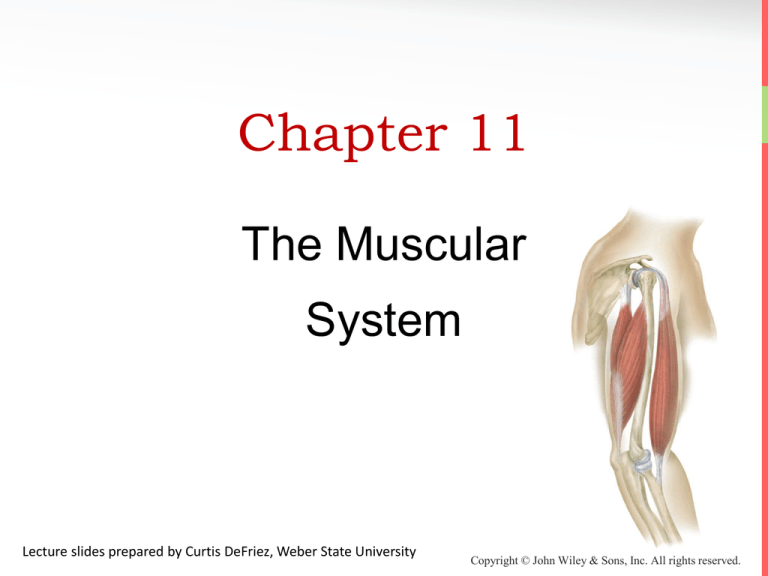
Chapter 11
The Muscular
System
Lecture slides prepared by Curtis DeFriez, Weber State University
Copyright © John Wiley & Sons, Inc. All rights reserved.
Naming Muscles
Location
tibialis anterior
Tibialis anterior
Copyright © John Wiley & Sons, Inc. All rights reserved.
Naming Muscles
Size
gluteus maximus
• Number of Attachments
o
biceps; triceps
Copyright © John Wiley & Sons, Inc. All rights reserved.
Naming Muscles
Location/Direction of Fibers
transversus abdominus
Copyright © John Wiley & Sons, Inc. All rights reserved.
Naming Muscles
Hyoid
bone
Styloid
process
• Attachments
(origin & insertion)
o
stylohyoid;
sternocleidomastoid
Copyright © John Wiley & Sons, Inc. All rights reserved.
Naming Muscles
Muscle action
levator scapulae
adductor magnus
tensor tympani
Levator scapulae
Copyright © John Wiley & Sons, Inc. All rights reserved.
Naming Muscles
Combination of above
Fibularis longus
Copyright © John Wiley & Sons, Inc. All rights reserved.
Origins and Insertions
Muscles produce movement by exerting force on
tendons which in turn pull on bones and other
supporting structures like the skin.
In order to produce movement around a joint, one bone
must be stationary while another bone moves.
The attachment of a muscle's tendon to the stationary,
usually proximal bone, is called the origin.
Copyright © John Wiley & Sons, Inc. All rights reserved.
Origins and Insertions
Insertion
of the
long head
of the
biceps
Copyright © John Wiley & Sons, Inc. All rights reserved.
Origins and Insertions
Biceps:
Origin: Scapula
Insertion: Radius
Action: pronate and
flex the arm
Triceps:
Origin:
Scapula near shoulder joint
Upper lateral and posterior sites
of humerus
Posterior surface of humerus
Insertion: Back of olecranon
process of ulna
Action: Straighten (extend) the
arm
Copyright © John Wiley & Sons, Inc. All rights reserved.
Musculoskeletal Levers
Muscles, tendons, bones, and joints can form three
different types of levers in the body.
When producing movement, bones act as levers, and
joints function as the fixed point
of movement called the fulcrum.
In a lever, the point of movement
(fulcrum) is acted on by two
different forces: Effort and load.
Copyright © John Wiley & Sons, Inc. All rights reserved.
Musculoskeletal Levers
There are few first-class levers
in the body
Copyright © John Wiley & Sons, Inc. All rights reserved.
Musculoskeletal Levers
Second class levers always provide a distinct mechanical
advantage in producing force.
Like a pry bar
Copyright © John Wiley & Sons, Inc. All rights reserved.
Musculoskeletal Levers
Third-class levers are the most common and favor
speed and range of motion over maximum force.
Copyright © John Wiley & Sons, Inc. All rights reserved.
Coordination Among Muscles
Movements are often the result of several skeletal muscles
acting as a group.
Most skeletal muscles are arranged in opposing
(antagonistic) pairs at joints.
Within opposing pairs, the prime mover or agonist
(“the leader”) is the muscle primarily responsible for
causing the desired movement.
Copyright © John Wiley & Sons, Inc. All rights reserved.
Coordination Among Muscles
The antagonist stretches and yields to the effects of the
prime mover.
In flexing the forearm at
the elbow, the brachialis
is the prime mover or
agonists, and the triceps
brachii is the antagonist.
Copyright © John Wiley & Sons, Inc. All rights reserved.
Coordination Among Muscles
Synergists are muscles used to prevent unwanted
movements at intermediate joints, or otherwise aid the
movement of the prime mover.
The biceps acts synergistically with the brachialis.
Fixator muscles are a type of synergist muscle that are
used to steady the proximal joints of a prime mover.
Shoulder stabilizers for the forearm flexors
Copyright © John Wiley & Sons, Inc. All rights reserved.
Major Skeletal Muscles
Learn the origin, insertion and action of the major skeletal
muscles of the body as directed by your instructor.
Some of the more common muscles of the head and neck
include:
Orbicularis oris
Extraocular muscles
Sternocleidomastoid
Rectus abdominus
External oblique
Copyright © John Wiley & Sons, Inc. All rights reserved.
Major Skeletal Muscles
The muscles of facial expression move skin rather than
bones around a joint.
Orbicularis oris
Action: Closes and
protrudes lips for kissing
Origin: Surrounding the
opening of the mouth
Insertion: The skin at the
corner of the mouth
Orbicularis
oris
Copyright © John Wiley & Sons, Inc. All rights reserved.
Major Skeletal Muscles
Muscles that move the mandible (lower jaw)
Also called muscles of mastication
Masseter
Origin: Maxilla and
zygomatic arch
Insertion: Mandible
Action: Closes the
mouth
Masseter
Copyright © John Wiley & Sons, Inc. All rights reserved.
Major Skeletal Muscles
The Extraocular muscles
3 pair give each eye very
precise movement
Origin: Back of the orbit
Insertion: Different parts
of the eyeball
Action: Precise and rapid
movement of the eyes
Copyright © John Wiley & Sons, Inc. All rights reserved.
Major Skeletal Muscles
Muscles that move the head
Sternocleidomastoid (commonly abbreviated as SCM)
Origin: Clavicle and sternum
Insertion: Mastoid
process of temporal bone
Action: Flex and
rotate the head
Sternocleidomastoid
Copyright © John Wiley & Sons, Inc. All rights reserved.
Major Skeletal Muscles
Some of the more common muscles that originate on the
trunk include:
Pectoralis major and
minor
Anterior abdominal
muscle group
Latissimus dorsi
Biceps brachii
Diaphragm
Trapezius
Deltoid
Copyright © John Wiley & Sons, Inc. All rights reserved.
Major Skeletal Muscles
Muscles that move the pectoral girdle (shoulder)
Pectoralis major
Pectoralis minor
Origin: Clavicle and
Origin: Ribs 3–5
sternum
Insertion: Coracoid
Insertion: Proximal
process of the scapula
humerus
Action: Internally rotates
Action: Adducts and
the shoulder
medially rotates the
arm at the shoulder joint
Copyright © John Wiley & Sons, Inc. All rights reserved.
Major Skeletal Muscles
Muscles that move the pectoral girdle (shoulder)
Deltoid Muscle
Origin: Lateral clavicle and upper scapula
Insertion: Deltoid tuberosity
Deltoid
on the shaft of the humerus
Action: Abducts, flexes, and
medially rotates the upper arm
at the shoulder joint
Copyright © John Wiley & Sons, Inc. All rights reserved.
Major Skeletal Muscles
Muscles that move the pectoral girdle (shoulder)
Trapezius
Origin: Occipital bone and
cervical spine
Trapezius
Insertion: Clavicle, scapula and
lower thoracic vertebrae
Action: Supports the arm and
moves the scapula up, down,
in, and out
Copyright © John Wiley & Sons, Inc. All rights reserved.
Major Skeletal Muscles
Muscles that move the pectoral girdle (shoulder)
Latissimus dorsi
Origin: Thoracic and lumbar
vertebrae and the iliac bone
Insertion: Mid-humerus
Action: Drives arm inferiorly
and posteriorly (the
Latissimus
dorsi
swimmer’s muscle)
Copyright © John Wiley & Sons, Inc. All rights reserved.
Major Skeletal Muscles
Anterior abdominal wall
Rectus abdominis
Origin: Pubic bone
Insertion: Ribs and sternum
External oblique
Origin: Ribs 5–12
Insertion: Iliac crest and
linea alba
Actions: Flexes vertebral column
and compresses abdomen
Copyright © John Wiley & Sons, Inc. All rights reserved.
Major Skeletal Muscles
The main muscle of inspiration is the diaphragm.
Origin: Inferior 6 ribs
(anteriorly) and lumbar
vertebrae (posteriorly)
Insertion: Central
tendon
Diaphragm
Central
tendon
Copyright © John Wiley & Sons, Inc. All rights reserved.
Major Skeletal Muscles
Some of the more common muscles of the extremities
include:
Triceps brachii
Quadriceps group: Rectus
Brachioradialis
femoris, along with the vastus
Thenar muscles
lateralis, vastus intermedius,
Hypothenar muscles
and vastus medialis
Gluteus maximus
Tibialis anterior
Biceps femoris
Gastrocnemius
Soleus
Copyright © John Wiley & Sons, Inc. All rights reserved.
Major Skeletal Muscles
Muscles that move the Radius and Ulna
Biceps brachii
Origin: Scapula
Insertion: Radius
Action: Flexes and
Brachialis
Origin: Distal anterior
surface
of humerus
Insertion: Ulna
supinates forearm at
Action: Flexor of forearm
elbow joint and flexes
at elbow
arm at shoulder joint
Copyright © John Wiley & Sons, Inc. All rights reserved.
Major Skeletal Muscles
Muscles that move the Radius and Ulna
Triceps brachii
Origin: Scapula and posterior surface of humerus
Insertion: Olecranon
process of ulna
Action: Extends
forearm at elbow
joint and arm
at shoulder joint
Copyright © John Wiley & Sons, Inc. All rights reserved.
Major Skeletal Muscles
Muscles that move the Radius and Ulna
Brachioradialis
Origin: Humerus
Insertion: Distal radius
Action: Supinates the forearm
at the radioulnar joint
Copyright © John Wiley & Sons, Inc. All rights reserved.
Major Skeletal Muscles
Muscles that move the wrist, hand, thumb,
and finger
Thenar: lateral aspect of palm
Hypothenar: medial aspect of palm
Action: Oppose thumb
against other 4 fingers
Thenar
Hypothenar
Copyright © John Wiley & Sons, Inc. All rights reserved.
Major Skeletal Muscles
Muscles that move the femur
Gluteus maximus
Origin: Iliac crest, sacrum,
and coccyx
Insertion: Femur
Action: Extends and
Gluteus
maximus
laterally rotates thigh at hip
joint
Copyright © John Wiley & Sons, Inc. All rights reserved.
Major Skeletal Muscles
Muscles that move the femur, tibia,
and fibula
Quadricep group (Rectus femoris,
vastus lateralis, vastus intermedius,
and vastus medialis)
Origin: Iliac spine and proximal
femur
Insertion: Patella and proximal tibia
Action: Flexes thigh at high joint
and extends leg at knee joint
Copyright © John Wiley & Sons, Inc. All rights reserved.
Major Skeletal Muscles
Muscles that move the
femur, tibia, and fibula
Hamstring group: (Biceps
femoris,
Semitendinosus, and
Semimembranosus)
Origin: Ischial tuberosity
Insertion: Proximal tibia
and fibula
Copyright © John Wiley & Sons, Inc. All rights reserved.
Major Skeletal Muscles
Muscles that move the femur, tibia,
and fibula
Tibialis anterior
Origin: Tibia
Insertion: First cuneiform
and first metatarsal
Action: Dorsiflexes and
inverts the foot
Copyright © John Wiley & Sons, Inc. All rights reserved.
Major Skeletal Muscles
Muscles that plantar flex the foot at the ankle joint
(standing on “tip toes”)
Gastrocnemius and soleus muscles
function as one – often called the
gastrocsoleus muscle
Origin: Femur, capsule of
knee, and head of fibula
Insertion: Calcaneus by way
of calcaneal (Achilles) tendon
Copyright © John Wiley & Sons, Inc. All rights reserved.
Major Skeletal Muscles
Copyright © John Wiley & Sons, Inc. All rights reserved.
Major Skeletal Muscles
Copyright © John Wiley & Sons, Inc. All rights reserved.
Imbalances of Homeostasis
Exercise-induced muscle damage
After intense exercise, electron micrographs reveal
considerable muscle damage including torn
sarcolemmas and disrupted Z-discs.
Blood levels of proteins normally confined only to
muscle (including myoglobin and the enzyme, creatine
kinase) increase as they are released from damaged
muscle.
Copyright © John Wiley & Sons, Inc. All rights reserved.
Imbalances of Homeostasis
Spasm
A sudden involuntary contraction of a single muscle
within a large group of muscles – usually painless
Cramp
Involuntary and often painful muscle contractions
Caused by inadequate blood flow to muscles (such as in
dehydration), overuse and injury, and abnormal blood
electrolyte levels
Copyright © John Wiley & Sons, Inc. All rights reserved.
Imbalances of Homeostasis
Disease States and Disorders
Fibrosis (myofibrosis)
Replacement of
muscle fibers by excessive amounts
of connective tissues (fibrous scar tissue)
Myosclerosis
Hardening
of the muscle caused by calcification
Both myosclerosis and muscle fibrosis occur as a result
of trauma and various metabolic disorders.
Copyright © John Wiley & Sons, Inc. All rights reserved.
Imbalances of Homeostasis
Aging
In part due to decreased levels of physical activity,
with aging, humans undergo a slow, progressive loss of
skeletal muscle mass that is replaced largely by fibrous
connective tissue and adipose tissue.
Muscle strength at 85 is about half that at age 25.
Compared to the other two fiber types, the relative
number of slow oxidative fibers appears to increase.
Copyright © John Wiley & Sons, Inc. All rights reserved.
End of Chapter 11
Copyright 2012 John Wiley & Sons, Inc. All rights reserved.
Reproduction or translation of this work beyond that permitted
in section 117 of the 1976 United States Copyright Act without
express permission of the copyright owner is unlawful. Request
for further information should be addressed to the Permission
Department, John Wiley & Sons, Inc. The purchaser may make
back-up copies for his/her own use only and not for distribution
or resale. The Publisher assumes no responsibility for errors,
omissions, or damages caused by the use of these programs or
from the use of the information herein.
Copyright © John Wiley & Sons, Inc. All rights reserved.









